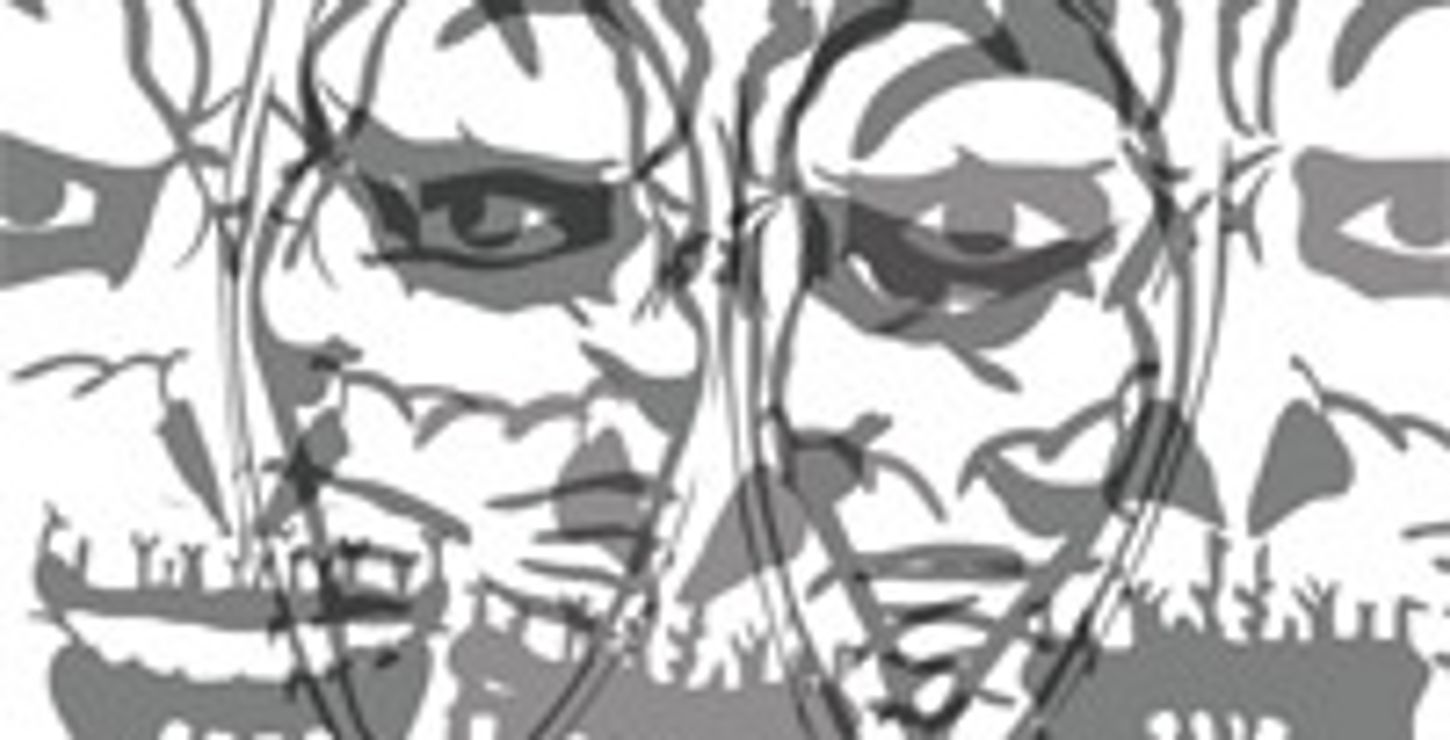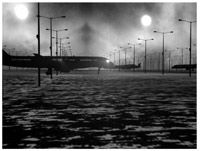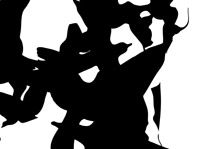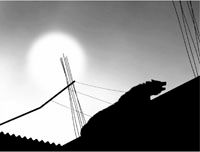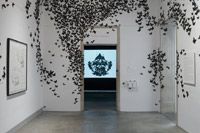Main Building
Over the last decade, Carlos Amorales has developed a unique visual vocabulary that he has used and reused, both alone and in collaboration with other artists, in mediums ranging from drawing and animation to installation and performance. In his growing and multifaceted body of work, Amorales presents a personal view of the world in which familiar images and objects are capable of invoking collective experiences of anxiety and fear, and in so doing questions and critiques the nature of our daily certainties.
Exhibition Minutes
Even the figurative has an abstract quality....
Amorales's fantasy worlds are inhabited by shadows of humans, birds, animals, and insects that coexist in ambiguous but invariably hostile surroundings. In these dark and inhospitable universes, the metamorphosis of humans into animals and of animals into humans occurs naturally, with shapes and forms merging with one another and evolving into threatening hybrids. These surreal visions are heavily influenced by gothic literature and mythological motifs, but are rooted in everyday reality. The result is a fragmented, postapocalyptic vision of life at the beginning of the twenty-first century in which the distinctions between good and evil, normal and abnormal, human and animal are blurred.
Sponsor
Generous support for this program is being provided by Agustín and Isabel Coppel.
Curator
Adelina Vlas • Assistant Curator, Modern and Contemporary Art
Location
Galleries 178 and 179, first floor
A Closer Look
The unique visual vocabulary that has become Carlos Amorales's signature style stems from his Liquid Archive, a digital database containing hundreds of drawings generated by the artist and subsequently used and reused in his multifaceted body of work. Begun in 1999, this growing collection of images is the tool that unifies Amorales's artistic oeuvre as its motifs migrate from medium to medium. For example, the spider webs, birds, kneeling figures, and silhouettes of trees used in the series of drawings Selected Ghosts (composition) (2008), presented in this exhibition, have appeared in previous drawings, animations, installations, and performances. In these drawings, the artist uses vector graphics to generate the outline of these familiar images, creating a sense that the images are on the verge of disappearing, and capturing their silhouettes just before the moment of dissolution, like the aura of a ghost. As an image bank, Amorales's archive becomes a visual vocabulary intended for collaborative use and reinterpretation, with the artist positioned as a critical filter, an interface between forms and their potential meaning. In his two-channel projection of video and animation Dark Mirror (2004), for instance, Amorales commissioned a graphic designer to create an animation using the archive and concurrently asked a musician to generate a score inspired by a selection of images derived from the same source. Together the two facets of the work form a coherent whole that positions Amorales in the role of editor or director. The way in which he allows the element of chance to define the final result of such collaboration reverberates with the open-ended scenarios he constructs in the works originating in the archive, particularly his animations. In these animations, nonfigurative elements complement images from the archive that are commonly associated with terror in the popular imagination, such as wolves, monsters, and hybrid creatures. Although the images are identifiable, it is the narrative into which they are incorporated that challenges and discomforts the viewer, an intentional strategy on the part of the artist, who tries to unsettle any sense of familiarity that could be associated with his choice of images. Like his drawings, the animations make reference to the concept of evil by summoning up the horror and fear associated with its presence in both the collective and individual subconscious. By giving form to these emotions, Amorales's work fulfills both a cathartic function, by allowing the audience to purge these feelings, and an apotropaic one, by deflecting these negative elements from those who encounter them. And while he allows for an accessible point of entry into his dark fantasies, once that threshold is crossed, it becomes entirely the viewer's responsibility to create his or her own story. Amorales's animations make that task particularly challenging by alternating between abstraction and figuration, narrative and nonnarrative sequences.
One of Amorales's first animations, Rorschach Test Animation (2004), brings into focus the artist's interest in abstraction and its potential for free association. Used as a means of psychological evaluation, the Rorschach test requires subjects to state what they see when confronted with ten bilaterally symmetrical inkblots. Taking the test as a point of departure, the artist generates a series of inkblots whose shape changes as the black spots progressively increase and decrease in number, producing new forms against the white background. Like test subjects, viewers of Amorales's animation are invited to use their imagination to construct the meaning of what they see. By creating new combinations, the animation allows that imagination to expand beyond the test's original purpose. In these sequences of changing inkblots lies the potential for a narrative to surface, one shaped by the subjectivity of visual free association.
Amorales more clearly pursues the concept of a narrative animation in Manimal (2005), one of his most ambitious black-and-white, single-channel videos. By combining three-dimensional animation techniques with two-dimensional drawings of silhouettes, the artist produces the effect of a virtual shadow theater. The accompanying soundtrack by Julián Lede is characterized by an electric heavy-metal rhythm whose mounting intensity creates a sense of tension as a story slowly emerges. In a postapocalyptic landscape dominated by barren trees and two glowing moons, a pack of wolves migrates from the wilderness to an urban environment by crossing an abandoned airstrip where several passenger planes are positioned. The only indication of a human presence is the erratic flight of a number of airplanes in the dark sky. Although the elements of a traditional narrative are in place, making sense of the sequence demands an imaginative effort. This is undoubtedly a dark tale, one in which, as the title suggests, man and animal have morphed into one sinister creature. In staging the drama of Manimal, Amorales chose for his cityscape adobe-style houses that resemble dwellings in the working-class districts of Mexico City. By choosing a familiar setting, the artist makes the game of free association personal, as aspects of his own life permeate the work. His critical voice clearly emerges as he presents an allegorical interpretation of the collective fears experienced by contemporary society. The barbed-wire fence separating the feral creatures from the realm of humans could be interpreted as a reference to current debate on anti-immigration policies designed to keep at bay those perceived to be different or dangerous. The alien element is never clearly defined in the video since its existence is a construct of the discourse of fear prevalent in today's sociopolitical climate. However, Amorales's crossbred creature carries the burden of the psychological damage inflicted by this discourse of fear. Its very hybridity reveals how the object of fear is already part of one's mental and emotional makeup—that, as in Manimal, the monsters live within us rather than among us. In this animation, the artist's critical perspective clearly emerges as he presents his personal view of a world veiled in fear. Hybridity returns as a motif in Faces (2007), Amorales's most recent black-and-white animation, in which he renews his efforts to build an abstract visual vocabulary of horror by amalgamating elements from his Liquid Archive at a fast-paced rhythm. From the multitude of shapes and forms that race across the screen, untamed gazes, masked faces, and carved profiles emerge for a split second only to disappear again in the amorphous mass that spewed them out. In Faces, the figurative components of the archive are pushed to the limits of representation. Here a new abstract language surfaces as Amorales's technique emulates the gestural painting method of Abstract Expressionists such as Jackson Pollock. The playfulness of Rorschach Test Animation comes to mind as the viewer struggles to identify familiar figures among the suggestive graphic forms that appear at an increasing speed. The rhythm of the animation sequences is dictated by a musical soundtrack in which sides A and B of a 1950s album of atonal music are played simultaneously with surprisingly harmonious results. Now and again an extraordinary, clearly defined face struggles to emerge from the nebulous fusion of shapes. For an instant it appears to gain enough materiality to jump out and exist as an independent physical object, but the illusion is short-lived and the features of the face return to the chaos from which they came, not to be seen again. This sense of materiality is the result of an animation technique employed by Amorales, where real faces covered in makeup and paper cutouts of various elements from the archive are manipulated and imbued with three-dimensional qualities.
With Black Cloud (2007), Amorales takes the Liquid Archive into the three-dimensional realm, materializing its potential for communicating terror by giving it an overwhelming physical presence. The artist replicates thirty-six types of moths—all culled from his archive—in thousands of life-size, black paper cutouts that are individually hand glued to the walls and ceiling of a space. Multiplied to create a dense mass with both wondrous and threatening qualities, Black Cloud becomes a surreal yet sublime gathering of insects delicately poised in sculptural formations that suggest the potential for harm, destruction, and irreversible doom. The biblical plagues of the Old Testament come to mind, as two of the ten calamities inflicted by God on Egypt, and recounted in Exodus, involved swarms of flies and locusts. The association of such a spectacular installation with a Judgment Day narrative indicates Amorales's propensity toward ambiguous scenarios where the boundaries between beauty and awe, good and evil, calm and calamity are constantly blurred and where imagination is called upon to mediate between multiple interpretations of the work. As Four Animations, Five Drawings, and a Plague confirms, Amorales's diverse artistic production is characterized by an abstract vocabulary of fantasy that invokes collective experiences of fear and horror as it sparks the imagination. While building this lexicon of the macabre, the artist reveals his personal vision of the world and a profound involvement with the artistic process through which he expresses it. In combining the visual motifs of the Liquid Archive and transposing them in various mediums, Amorales creates new and exhilarating works of art demonstrating not only that a unique visual language can still emerge but also that, as he strongly believes, the artist's critical voice is imperative as the art and the everyday become more indistinguishable.
Works on View
Carlos Amorales
Mexican
Born 1970The Forest
2003
Digital animation; 1 minute, 38 seconds
Direction, animation, and music by Carlos Amorales Rorschach Animation Test
2004
Digital animation; 5 minutes, 24 seconds
Direction, animation, and music by Carlos Amorales Manimal
2005
Digital animation; 5 minutes, 26 seconds
Direction by Carlos Amorales
Animation by Ivan Martinez Lopez
Music by Julián Lede Faces
2007
Digital animation after paper cutout plates; 11 minutes, 36 seconds
Direction by Carlos Amorales
Animation by Ivan Martinez Lopez
Music concept by Julián Lede Black Cloud
2007
Black paper moths
Collection of Diane and Bruce Halle Selected Ghosts (composition) 01
2008
Paper collage Selected Ghosts (composition) 02
2008
Paper collage Selected Ghosts (composition) 03
2008
Paper collage Selected Ghosts (composition) 04
2008
Paper collage Selected Ghosts (composition) 05
2008
Paper collage All animations and collages courtesy Carlos Amorales and Yvon Lambert Gallery New York/Paris.
About Live Cinema
Live Cinema is a series of programs in the Film and Video Gallery of the Museum that explores the vast production of single-channel video and film work by a diverse group of local, national, and international artists. In the last decade an ever-increasing number of contemporary artists have appropriated these mediums as an artistic outlet, in a dialogue with the early video and Super 8 practices of the sixties and the tradition of experimental filmmaking. Each program of the Live Cinema series focuses on a specific aspect of this work, in order to both map and analyze this important facet of contemporary art production. Certain programs are accompanied by a brochure in which writers discuss the works exhibited, and by public lectures given by the participating artists.
